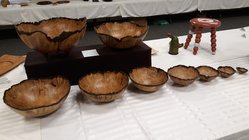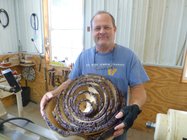Having a lot of fun with my new Oneway coring system, and starting to plan ahead for the next tree to come down. I just realized that I don't know how thick to cut the blanks for efficient coring. Obviously the larger the diameter the deeper I can go so the thicker the blank needs to be. For the 13-14" blanks I started with and got three bowls out of, it looks like I started with a blank about 4 1/2 - 5" thick. To go one bowl bigger, up to 16" with a #3 knife I should probably have a blank an inch and a half thicker so probably about 6" thick? What about 18" using a #4 knife?
Has anyone worked up a chart for this?
Has anyone worked up a chart for this?


